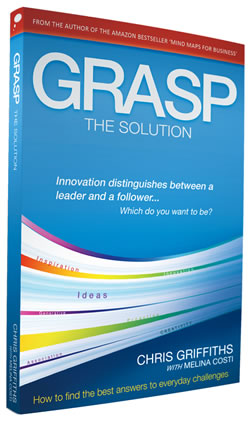 Mind mapping is one of the most powerful tools for capturing and cultivating ideas, says Chris Griffiths, CEO of ThinkBuzan in his new book, GRASP the Solution: How to Find the Best Answers to Everyday Challenges. Not only is it an excellent medium for capturing your ideas visually, it also enhances three types of thinking that are critical to the creative process:
Mind mapping is one of the most powerful tools for capturing and cultivating ideas, says Chris Griffiths, CEO of ThinkBuzan in his new book, GRASP the Solution: How to Find the Best Answers to Everyday Challenges. Not only is it an excellent medium for capturing your ideas visually, it also enhances three types of thinking that are critical to the creative process:
Divergent thinking: “By radiating branches from the center outwards, a mind map encourages your thoughts to behave in the same way so you can explore many possible solutions without limitation or restriction. Entering new ideas or building up existing ones is as easy as connecting another branch to either the central theme or main branch. The key elements of mind mapping, such as key words, colors and images, aid in drawing out novel ideas and perspectives that wouldn’t necessarily be revealed using more conventional note-taking techniques.”
Structured thinking: “Contrary to what some people believe, mind map is not ‘unstructured thinking.’ In fact, it’s one of the most structured forms of thinking possible, employing a number of organizing principles such as a central theme, basic ordering ideas, secondary and tertiary ideas, and so on. The central theme, in particular, keeps you focused on your main goal while still allowing you to think freely and expansively as you work around it. What this means is that you can be as generative as you like – letting your thoughts range far and wide – but can refer back to your central theme at any point so that you don’t go astray of your task… the mind map gives you the structure in which to organize and categorize your ideas in ways that are most relevant to what you’re trying to achieve.”
Holistic thinking: “A mind map allows you to get a ‘bigger picture’ view of all of your ideas and options so you can clearly see the relationships among them. Just as the branches in a mind map are all connected, so are all the ideas in relation to each other. This gives a mind map a depth and breadth of scope that a simple list of ideas can’t match. From this perspective it becomes easier to springboard off ideas to create new ones more rapidly and thoroughly.”
I knew that mind mapping supported creative thinking, but I haven’t seen such a clear, in-depth explanation until now. Based on my first look at GRASP the Solution, I can tell this is one of those must-have books for any serious mind mapper. Like the previous book that Griffiths co-wrote with Tony Buzan – Mind Maps for Business – this one is full of practical advice and clear, and is focused with laser-like precision on the needs of business people today. I highly recommend this book!
GRASP the Solution will be released on October 19, 2011.

Leave a Reply